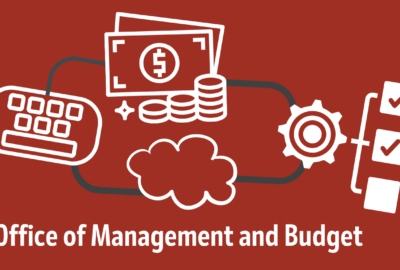Hubbard Radio Washington DC, LLC. All rights reserved. This website is not intended for users located within the European Economic Area.
HHS proves NOFOs can be less complex, easier for applicants
OMB updated the Uniform Grants Guidance for the first time since 2020 with a new template for NOFOs to help agencies reduce the burden on grantees.
Agencies put out thousands of notices of funding opportunity (NOFO) for grants every year. And like many things across the government, NOFOs have gotten bigger and more complex over time.
The Department of Health and Human Services is trying to stem the NOFO tide with a new pilot aiming to streamline and simplify these notices.
And the success of this limited pilot turned into a key piece to the bigger grants management revamp that the Office of Management and Budget detailed on April 4.
“I’m particularly proud of one area of this guidance, something our team has been really focused on from the get go, ensuring that an overhaul to this guidance lowers burden on recipients. Of course, we need strong and clear rules for how federal funds are spent. But those rules should add value, not create ‘check the box’ burdens, red tape, even when well-intended increases costs and reduces the amount of federal funding recipients can spend on delivering outcomes,” said Jason Miller, OMB’s deputy director for management, at the Uniform Grants Guidance launch on April 4. “Lowering burden, which is exactly what this new guidance will do, means that we get more value from every dollar, shifting minutes and shifting dollars from administrative work and overhead to mission work.”
The burden that built up over time around NOFOs is a common concern for state, local and non-profit organizations. And with the amount of money the government has been awarding through grants reaching an all-time high of $1.2 trillion in fiscal 2023, OMB and HHS recognized the need to reduce the complexity of funding opportunities.

“The changes to this particular section of the guidance include requirements for plain language, including only necessary information. It’s been my experience at HHS that over time, you just keep adding pieces of paper, Appendix AA, but nobody ever looks to see which of those could be peeled back. Are they still necessary? Or is there duplication? Does it add value? Is it really helping us deliver?” said Andrea Palm, the deputy secretary of HHS, at the event. “So really taking a look at all of those things and only including necessary information is a way in which we can simplify this process, make it more accessible to communities all across the country and be really clear about the eligibility requirements.”
She added the guidance updates also will give agencies greater flexibility to design the NOFO. She said it will be much more intuitive to expand the pool of potential applicants.
The HHS pilot showed that reducing the number of pages that make up NOFOs can be done and the grant still meets all the compliance and outcome goals, she said.
The HHS Simpler NOFOs Pilot Initiative kicked off in 2023 and the initial results proved out the agency’s theory.
Pilot showed reduction in pages, time
HHS’s Administration for Children and Families and the Health Resources and Services Administration are among the bureaus taking part in the pilot.
At the end of March, ACF detailed big changes to their NOFOs based on the prototype that HHS redesigned and evaluated last fiscal year. ACF says the results showed the prototypes reduced the average time to complete an application by 31%, the page count by 17% and the reading level by 4 grade levels.
ACF says it has 25 NOFOs participating in this pilot project and it will publish these pilot NOFOs over the next several months.
HRSA has nine NOFOs in the pilot currently.
Based on the HHS pilot, OMB said agencies should aim to reduce word count of existing NOFOs by 25% over the previously issued version. They should also eliminate unnecessary provisions, and move content that is not directly related to the core activities to be performed under the federal award, such as any assurances to appendices on linked webpages.
“The uniform grant guidance includes a streamlined NOFO template for agencies to use to help with shortening and simplifying their grant announcements. Through this streamlined template agencies are directed to use plain language and write in a manner and a level that is accessible for any potential applicant,” OMB’s Miller said. “To ensure that this work takes hold agencies will have to submit a plan to OMB for how they’re going to simplify their grants as we move forward.”
New council to lead oversight efforts
The Council on Federal Financial Assistance (COFFA), which OMB launched last fall, developed a template that agencies must conduct an assessment to identify the NOFOs that will be prioritized for simplification in fiscal 2025.
OMB’s implementation memo says that template will include several factors, such as statutory complexity, and prioritize for simplification those NOFOs that have higher numbers of applicants, make frequent awards, make a large number of awards and have average award amounts that would be appropriate for limited capacity or first-time applicants, such as those between $1 million and $50 million.
Based on the assessment, agencies must submit a NOFO simplification plan to OMB by Aug. 1.
During 2025, agencies will implement their approved plan and by 2026, agencies will continue to simplify their existing NOFOs until all NOFOs have been simplified according to guidelines provided by COFFA.
Along with the NOFO changes, the new guidance outlined several other significant changes to grants. Another change agencies should be aware of is grant recipients can now use some of the funding they receive for data and evaluation of their programs.
Previously, it was unclear whether grantees could use federal funds in this way, but OMB and the recipients believe by specifically calling this out, it will enhance grantees’ ability to make data driven decisions.
Deadlines for grants guidance set
It also lets agencies publish NOFOs in other languages besides English, which potentially broadens the pool of recipients.
Another change involves how agencies use the federal program inventory portal. Earlier this year, OMB launched a federal program inventory, which is a new comprehensive, searchable tool with information about all federal programs that provide grants, loans or direct payments to individuals, governments, firms or other organizations.
Agencies will be required to improve the official descriptions of their programs, or assistance listings, which feed the inventory. The have to complete that initial assessment and come up with an initial plan by Nov. 15 for how they are going to improve the FPI listings.
The NOFO deadlines are just a few that OMB outlined in the implementation memo. OMB directed agencies to put the revisions into effect by Oct. 1, and provides additional tools to strengthen and streamline the administration of federal financial assistance.
But by May 15, all agencies must submit to OMB their plan for implementing the 2024 Revisions.
The COFFA council will oversee the long-term oversight and implementation of the new guidance.
“Now terms like federal financial assistance and uniform grant guidance may sound mundane or perhaps a little bit bureaucratic. But it’s really the plumbing of our federal programs; plumbing matters,” OMB’s Miller said. “This guidance will promote a culture of improved stewardship. It will allow for more streamlined implementation. It will provide for more effective oversight of federal programs that will reduce burden and result in more dollars going to outcomes instead of overhead, and it will broaden the pool of potential recipients.”
Copyright © 2024 Federal News Network. All rights reserved. This website is not intended for users located within the European Economic Area.
Jason Miller
Jason Miller is executive editor of Federal News Network and directs news coverage on the people, policy and programs of the federal government.
Follow @jmillerWFED
Related Stories
With 40% of funds spent on compliance, OMB aims to give grantees some relief
Related Stories
-
With 40% of funds spent on compliance, OMB aims to give grantees some relief Reporter's Notebook





